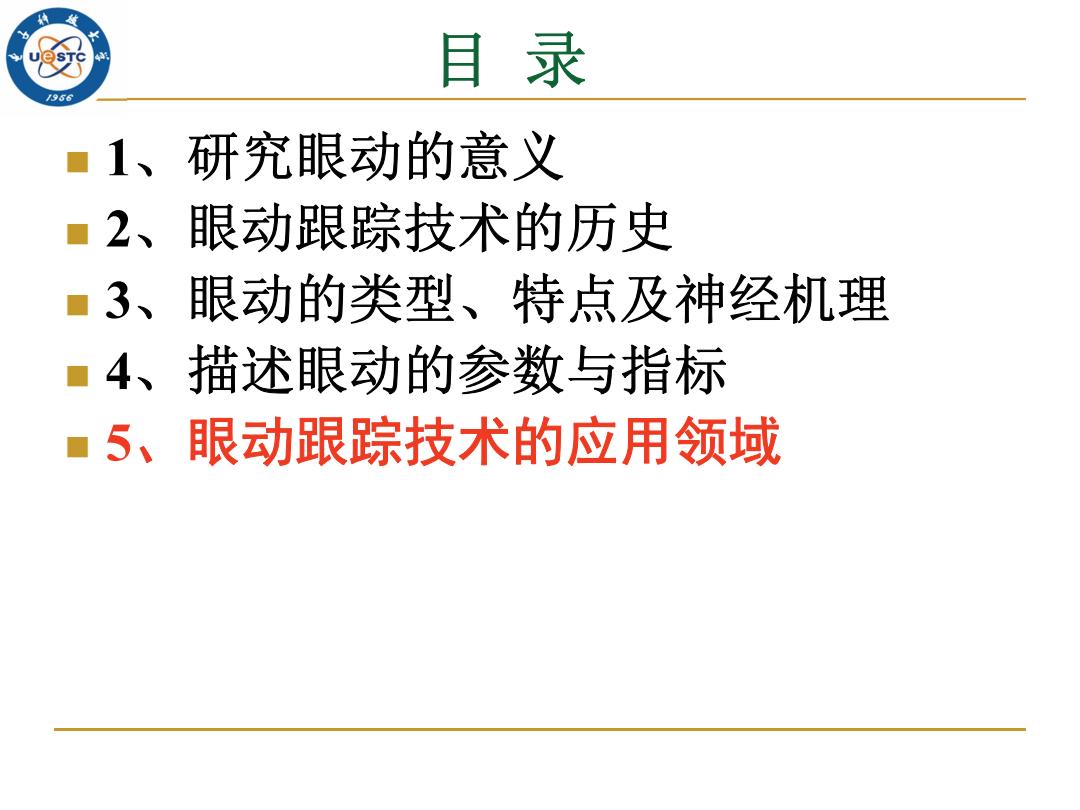
目录 /956 ■1、研究眼动的意义 ·2、眼动跟踪技术的历史 ■3、眼动的类型、特点及神经机理 ·4、描述眼动的参数与指标 ■5、眼动跟踪技术的应用领域
目 录 1、研究眼动的意义 2、眼动跟踪技术的历史 3、眼动的类型、特点及神经机理 4、描述眼动的参数与指标 5、眼动跟踪技术的应用领域
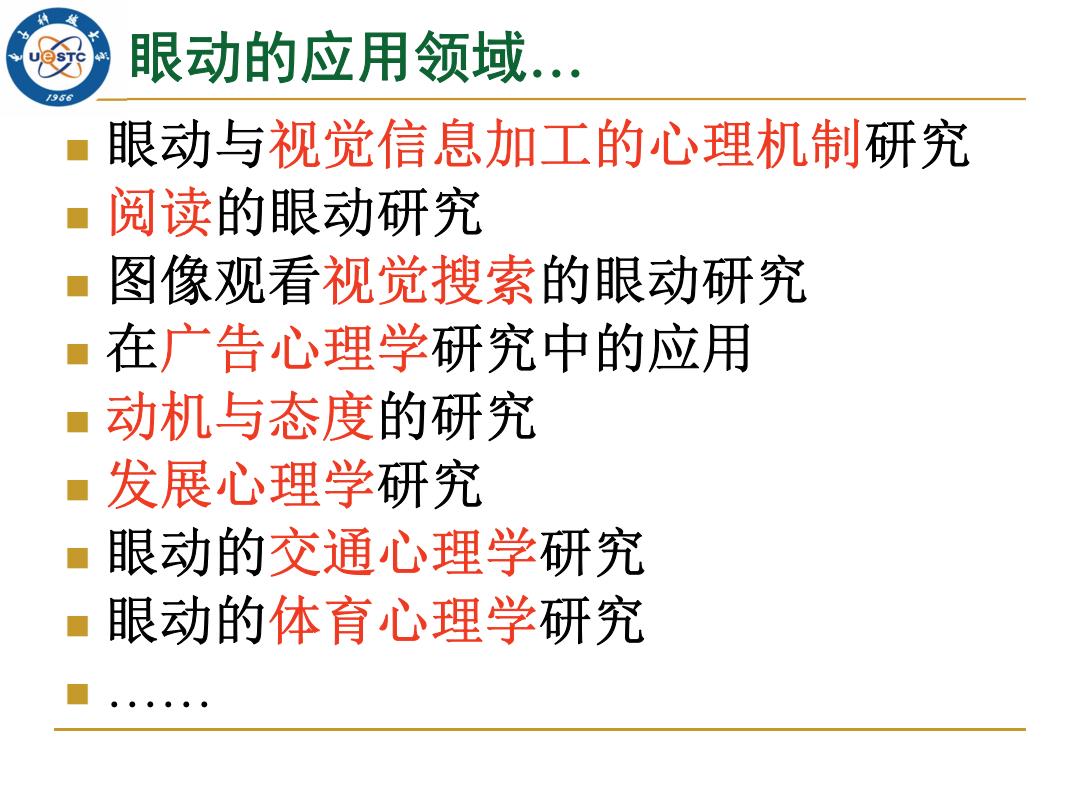
眼动的应用领域 /956 眼动与视觉信息加工的心理机制研究 阅读的眼动研究 图像观看视觉搜索的眼动研究 在广告心理学研究中的应用 动机与态度的研究 ·发展心理学研究 眼动的交通心理学研究 眼动的体育心理学研究
眼动的应用领域 … 眼动与视觉信息加工的心理机制研究 阅读的眼动研究 图像观看视觉搜索的眼动研究 在广告心理学研究中的应用 动机与态度的研究 发展心理学研究 眼动的交通心理学研究 眼动的体育心理学研究 ……
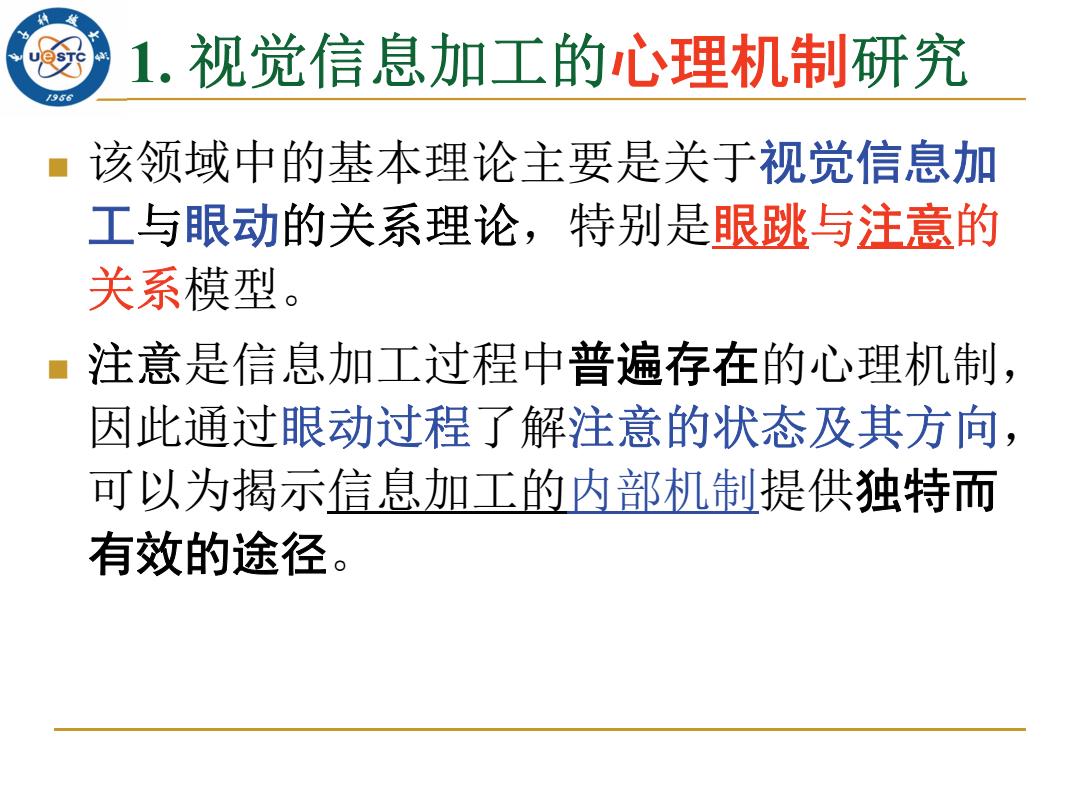
1.视觉信息加工的心理机制研究 该领域中的基本理论主要是关于视觉信息加 工与眼动的关系理论,特别是眼跳与注意的 关系模型 注意是信息加工过程中普遍存在的心理机制, 因此通过眼动过程了解注意的状态及其方向, 可以为揭示信息加工的内部机制提供独特而 有效的途径
1. 视觉信息加工的心理机制研究 该领域中的基本理论主要是关于视觉信息加 工与眼动的关系理论,特别是眼跳与注意的 关系模型。 注意是信息加工过程中普遍存在的心理机制, 因此通过眼动过程了解注意的状态及其方向, 可以为揭示信息加工的内部机制提供独特而 有效的途径
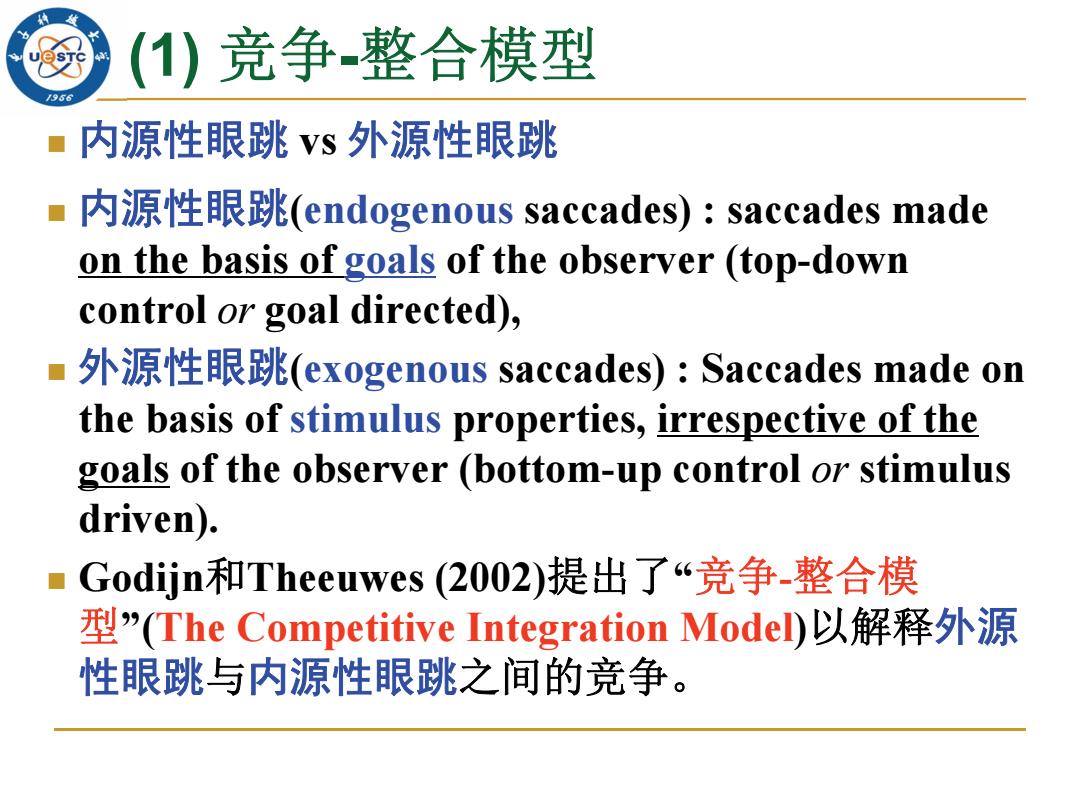
(1)竞争-整合模型 /966 内源性眼跳ⅴs外源性眼跳 内源性眼跳(endogenous saccades):saccades made on the basis of goals of the observer (top-down control or goal directed), 外源性眼跳(exogenous saccades):Saccades made on the basis of stimulus properties,irrespective of the goals of the observer (bottom-up control or stimulus driven). Godijn和Theeuwes(2002)提出了“竞争_整合模 型”(The Competitive Integration Model)以解释外源 性眼跳与内源性眼跳之间的竞争
(1) 竞争-整合模型 内源性眼跳 vs 外源性眼跳 内源性眼跳(endogenous saccades) : saccades made on the basis of goals of the observer (top-down control or goal directed), 外源性眼跳(exogenous saccades) : Saccades made on the basis of stimulus properties, irrespective of the goals of the observer (bottom-up control or stimulus driven). Godijn和Theeuwes (2002)提出了“竞争-整合模 型”(The Competitive Integration Model)以解释外源 性眼跳与内源性眼跳之间的竞争
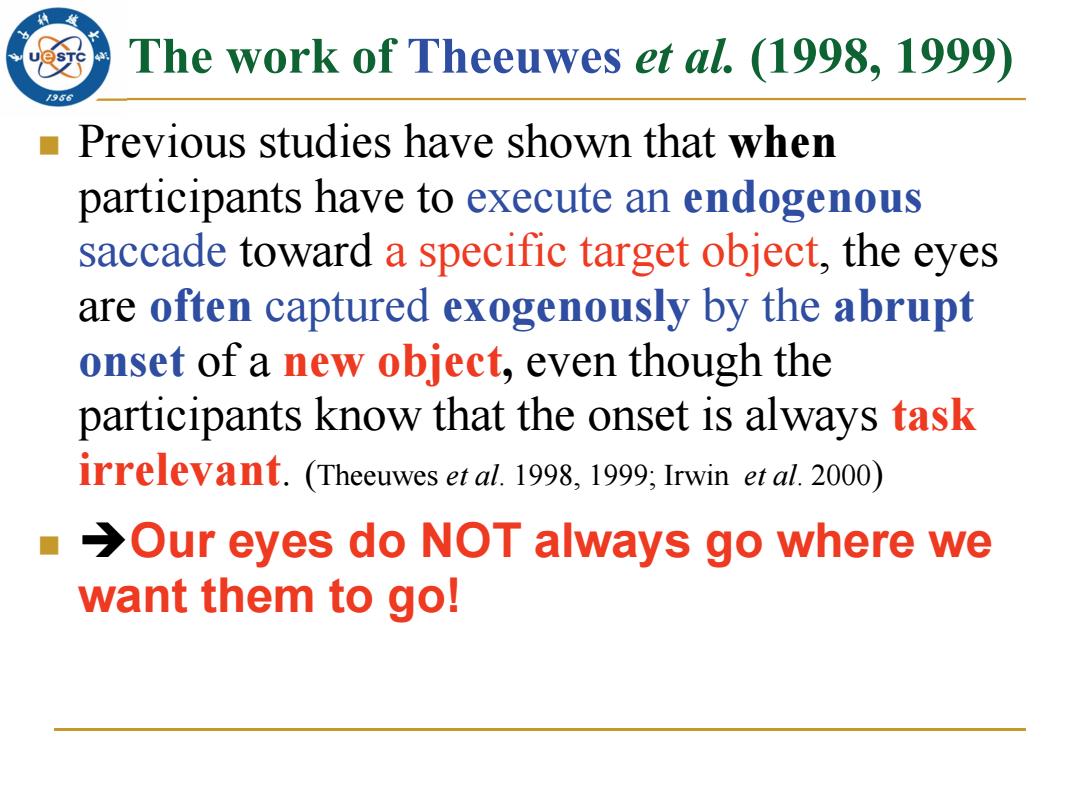
The work of Theeuwes et al.(1998,1999) /956 Previous studies have shown that when participants have to execute an endogenous saccade toward a specific target object,the eyes are often captured exogenously by the abrupt onset of a new object,even though the participants know that the onset is always task irrelevant.(Theeuwes et al.1998,1999;Irwin et al.2000) ■→Our eyes do NOT always go where we want them to go!
The work of Theeuwes et al. (1998, 1999) Previous studies have shown that when participants have to execute an endogenous saccade toward a specific target object, the eyes are often captured exogenously by the abrupt onset of a new object, even though the participants know that the onset is always task irrelevant. (Theeuwes et al. 1998, 1999; Irwin et al. 2000) Our eyes do NOT always go where we want them to go!

Onset distractor 任务: 红色的distractor 眼跳至此 E X 在target出现后的 处,并识 0,80,150ms出现 别圈中的 Target 字母 (target) 剩一个不变,其余的圆圈由灰 + 虚线→红实线;所有的圈中的 mask变成字母。 Fixation (Theeuwes et al.1999) ® Figure 1.Sequence of events during a trial.After a 1,000-ms fixation,all gray circles (dashed lines)except one changed to red 國 * (solid lines);at the same time the small premask inside the circles 1000ms changed to letters.Depending on the condition an additional red onset distractor circle was added to the display with either a 0-,80-, or 150-ms stimulus onset asynchrony.Participants had to make an ⑧ eye movement to the gray circle (color singleton)and respond to the identity of the small letter located inside the gray circle.The stimuli are not drawn to scale
1000ms 红色的distractor 在target出现后的 0,80,150ms出现 剩一个不变,其余的圆圈由灰 虚线 红实线;所有的圈中的 mask变成字母。 任务: 眼跳至此 处,并识 别圈中的 字母 (target) (Theeuwes et al. 1999)

Control (30 degrees) Abrupt onset at 30 degrees ◆8个被试; ◆Distractor-与target 同时出现时的情况 (即distractor在 Control(90 degrees) Abrupt onset at 90 degrees target出现后的0ms 出现) Figure 3.Eye movement behavior in the condition in which an abrupt onset was presented simultaneously with the target(0-ms stimulus onset asynchrony).The results are collapsed over all 8 participants and normalized with respect to the position of target Control(150 degrees) Abrupt onset at 150 degrees and onset.Sample points (every 4 ms)were taken only from the first saccade.Left panels:Eye movement behavior in the control condition in which no abrupt onset was presented.Right panels: Eye movement behavior in the condition in which an abrupt onset was presented simultaneously with the singleton target,either close to the singleton target (at 30 of arc corresponding to a distance of 6.4 of visual angle,see top right panel),somewhat farther away from the singleton target (at 90 of arc corresponding to a distance of 19.4 of visual angle,see middle right panel),or at a side of the visual field opposite to that of the target singleton (at 150 of arc corresponding to a distance of 25.4 of visual angle,see bottom right panel). (Theeuwes et al.1999)
8个被试; Distractor与target 同时出现时的情况 (即distractor在 target出现后的0ms 出现)。 (Theeuwes et al. 1999)
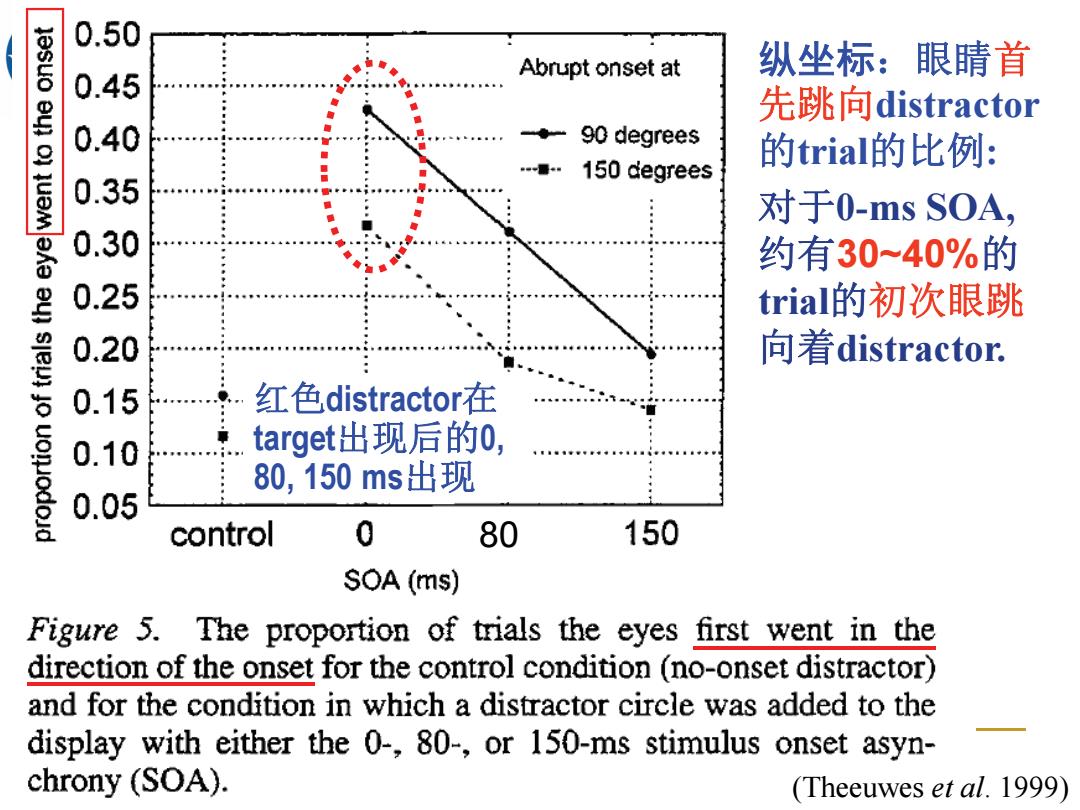
0.50 纵坐标:眼睛首 0.45 Abrupt onset at 先跳向distractor 0.40 90 degrees 的trial的比例: 150 degrees 对于0-msS0A, 4卡。。。生44年=生。444。。年年。年 约有30~40%的 trial的初次眼跳 向着distractor. 红色distractor在 0.10 target出现后的0, 0.05 80,150ms出现 control 0 80 150 SOA (ms) Figure 5.The proportion of trials the eyes first went in the direction of the onset for the control condition (no-onset distractor) and for the condition in which a distractor circle was added to the display with either the 0-,80-,or 150-ms stimulus onset asyn- chrony (SOA). (Theeuwes et al.1999
纵坐标:眼睛首 先跳向distractor 的trial的比例: 对于0-ms SOA, 约有30~40%的 trial的初次眼跳 向着distractor. (Theeuwes et al. 1999) 80 红色distractor在 target出现后的0, 80, 150 ms出现
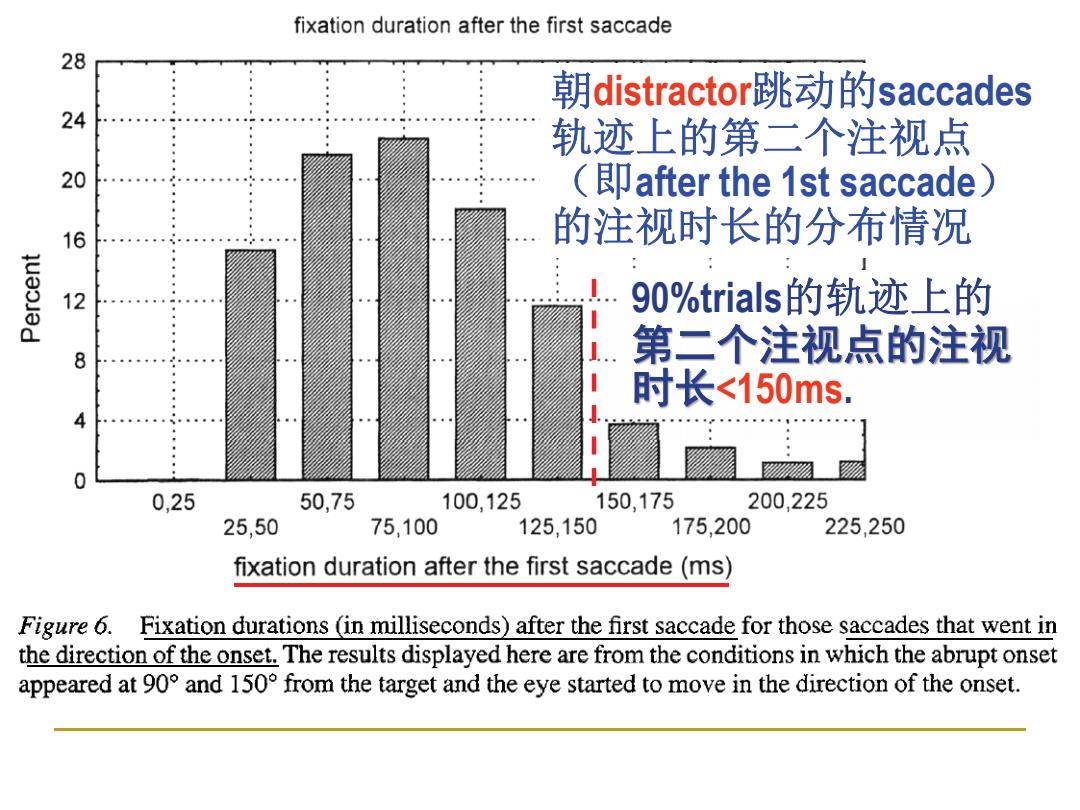
fixation duration after the first saccade 28 朝distractor跳动的saccades 24 轨迹上的第二个注视点 20 (after the 1st saccade) 16 的注视时长的分布情况 12 90%trials的轨迹上的 第二个注视点的注视 8 时长<150ms. 0,25 50,75 100,125 150,175 200,225 25,50 75,100 125,150 175,200 225,250 fixation duration after the first saccade(ms) Figure 6.Fixation durations (in milliseconds)after the first saccade for those saccades that went in the direction of the onset.The results displayed here are from the conditions in which the abrupt onset appeared at 90 and 150 from the target and the eye started to move in the direction of the onset
朝distractor跳动的saccades 轨迹上的第二个注视点 (即after the 1st saccade ) 的注视时长的分布情况 90%trials的轨迹上的 第二个注视点的注视 时长<150ms
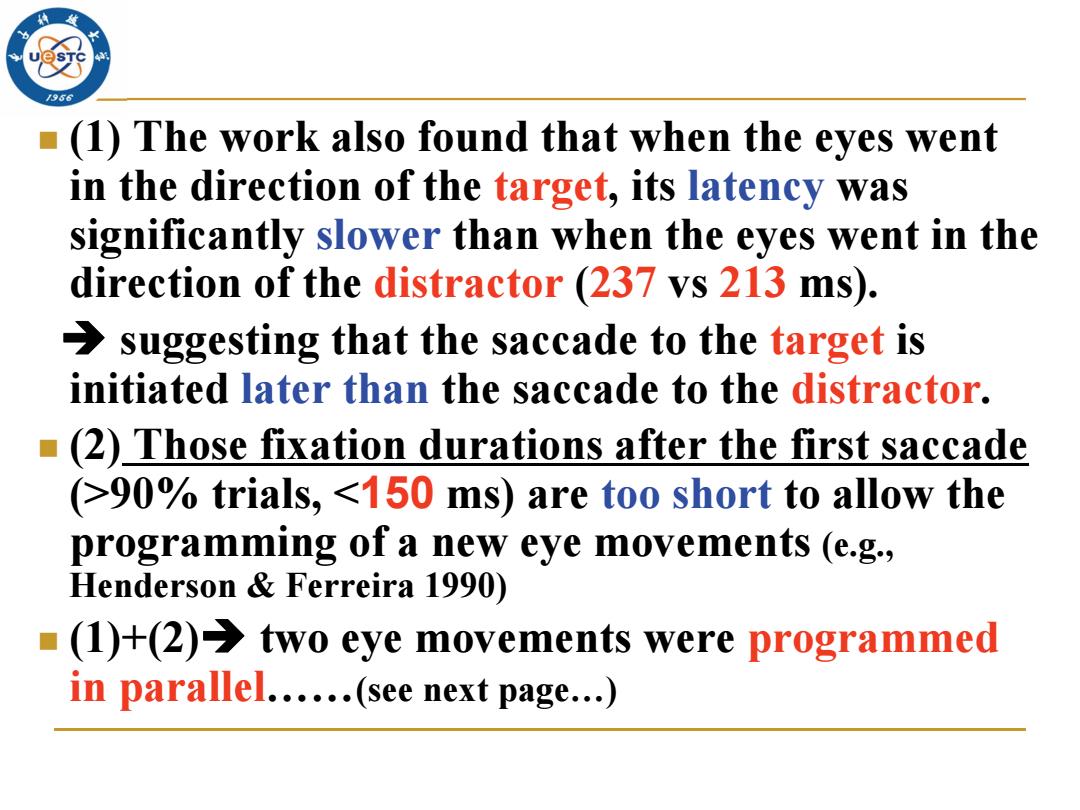
/956 (1)The work also found that when the eyes went in the direction of the target,its latency was significantly slower than when the eyes went in the direction of the distractor (237 vs 213 ms). >suggesting that the saccade to the target is initiated later than the saccade to the distractor. (2)Those fixation durations after the first saccade (>90%trials,two eye movements were programmed in parallel......(see next page...)
(1) The work also found that when the eyes went in the direction of the target, its latency was significantly slower than when the eyes went in the direction of the distractor (237 vs 213 ms). suggesting that the saccade to the target is initiated later than the saccade to the distractor . (2) Those fixation durations after the first saccade (>90% trials, <150 ms) are too short to allow the programming of a new eye movements (e.g., Henderson & Ferreira 1990) (1)+(2) two eye movements were programmed in parallel……(see next page…)